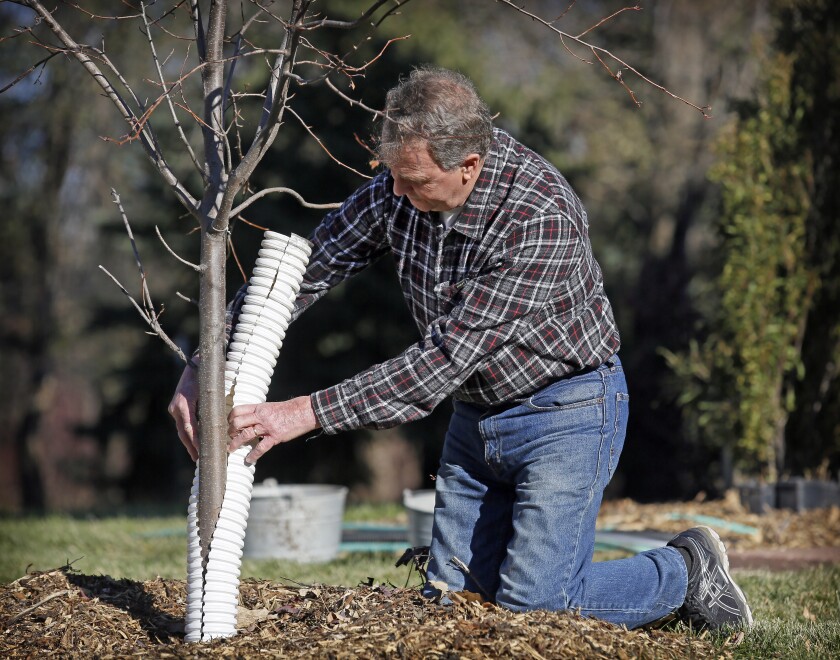You can tell the days are getting chillier, now that the mosquitoes are wearing flannel shirts.
Chilly weather and widespread freezes have put another growing season in the record books. Before we totally close up shop outdoors, it’s wise to take one last look around the yard and garden to make sure everything is tucked in for the winter.
Following is a last-minute checklist for buttoning up the yard and garden:
Rabbits can ruin fruit trees and some shrubs in late fall and winter when other food sources become snow-covered. Besides apple, plum and pear trees, vulnerable shrubs include rose, arborvitae, hydrangea, spirea, burning bush and raspberry. Fencing is the most reliable deterrent, but repellents like Liquid Fence and Plantskydd have proven successful for many homeowners.Because soil typically freezes in the first half of November as night temperatures consistently drop below 32 degrees F., pound stakes or posts in the ground well in advance if protective fencing is desired.Add protective mulch around roses, strawberries and tender perennials after soil has started to freeze in November. A layer 12 to 24 inches thick of leaves, straw or shredded wood keeps plants comfortably frozen, but insulated from extreme cold, which is especially important if we have a repeat of last winter’s lack of insulating snow cover.

Check to be sure water hoses are disconnected from outdoor spigots and watering wands, nozzles, sprinklers and rain gauges are drained to prevent breakage.Move yard and garden liquid herbicides and insecticides to a location that won’t freeze. Garages, unless reliably kept above freezing, are poor locations for winter storage of liquid chemicals, most of which are ruined by freezing. Because many chemicals exude objectionable odors once the original seal is broken, enclose the containers in tightly sealed plastic bags if moving the chemicals to a basement or other living space.Remove dead plants from outdoor containers to reduce next year’s disease potential.Voles, the grayish brown short-tailed field mice, can ruin trees and shrubs as they gnaw bark, and damage lawns as they tunnel below snow cover. Repellents give mixed results. Besides natural predators, the most effective controls are traps baited with peanut butter or peanuts, or poisoned baits placed in lengths of PVC pipe to keep the baits away from humans or pets. Wire mesh hardware cloth with quarter-inch openings can be circled around tree trunks.Give the lawn its final mowing when the grass is beginning to go brown and dormant, reducing the height to 2 inches.Cover tree trunks to prevent winter sunscald damage to thin-barked trees, since most damage occurs from December on. Fruit trees, maples, lindens and trees less than five years old are especially vulnerable. Garden centers sell tree wrapping material, including the common white tube-like cylinders.

Wrapping trees can reduce winter sunscald and animal damage.
David Samson / Forum file photo
Rake up fallen and damaged apples and dispose, if you haven’t already done so.Cut back the above-ground “tops” of iris, hosta and daylily, which turn to mush by next spring, also peonies for disease control. Other perennials and ornamental grasses can be left intact during winter, which aids in their survival, helps catch snow, provides habitat for pollinators and adds winter beauty.Give one last soak to evergreens and newly planted trees and shrubs, if fall rainfall is lacking in your area.Any trees, shrubs, bulbs or perennials that were bought, but still not planted, should be installed quickly before soil freezes. All are better in the ground than trying to overwinter unplanted. Mulch with 12-24 inches of straw or leaves after planting.

Tender perennials and newly planted items benefit from a mulch of leaves or straw applied in early November.
David Samson / Forum file photo
Leaves can be added as a surface mulch over vegetable gardens and raised beds, or incorporated in.It’s easy to neglect garden tools at the end of the season, but good-quality tools can last a lifetime with proper care. Scrape away excess soil, finishing with steel wool or sandpaper, and give a light coat of oil to prevent rust. Rub wooden handles with a mixture of equal parts linseed oil and turpentine.Before solidly frozen soil makes it impossible, drive wooden stakes or other labels to mark the locations of young perennials or bulbs, so you know where to expect them to emerge next spring.Although I’m always certain I’ll remember which cultivars of flowers and vegetables performed best this summer, I often forget by the following spring. It helps to write them down now, while the memories are fresh.

Don Kinzler, a lifelong gardener, is the horticulturist with North Dakota State University Extension for Cass County. Readers can reach him at donald.kinzler@ndsu.edu.


Comments are closed.